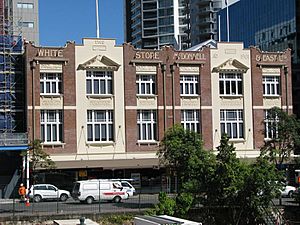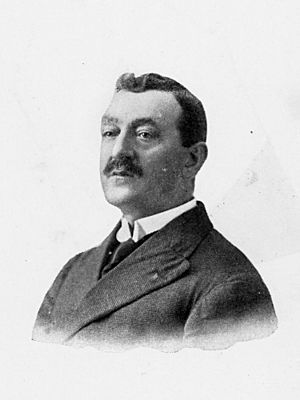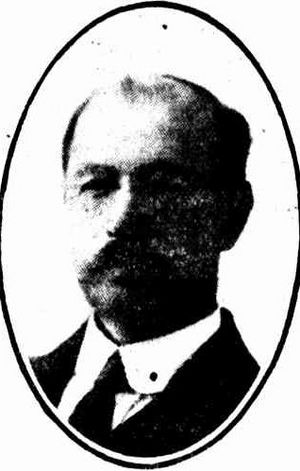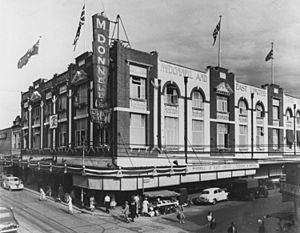- This page was last modified on 17 October 2025, at 10:18. Suggest an edit.
McDonnell & East Ltd Building facts for kids
| McDonnell & East Ltd Building | |
|---|---|

McDonnell & East Ltd Building, 2008
|
|
| Location | 414 George Street, Brisbane City, City of Brisbane, Queensland, Australia |
| Design period | 1900 - 1914 (early 20th century) |
| Built | 1912 - 1928 |
| Architect | Thomas Ramsay Hall |
| Architectural style(s) | Arts & Crafts |
| Official name: McDonnell & East Ltd Building | |
| Type | state heritage (built) |
| Designated | 10 December 1997 |
| Reference no. | 600120 |
| Significant period | 1912, 1914, 1925-1928 (fabric) 1931-1990, 1984 (historical) |
| Builders | Andrew Gillespie |
| Lua error in Module:Location_map at line 420: attempt to index field 'wikibase' (a nil value). | |
The McDonnell & East Ltd Building is a historic building in Brisbane, Australia. It used to be a large department store, which is a big shop selling many different kinds of goods. This building is special because it is listed on the Queensland Heritage Register, meaning it's an important part of Queensland's history and architecture. It was designed by Thomas Ramsay Hall and built in different stages between 1912 and 1928.
Contents
A Store's Story: From Idea to Icon
How It All Began
The story of this building starts with two Irishmen, Frank McDonnell and Hubert East. They moved to Brisbane in 1886 and worked in the "drapery trade," which means they sold fabrics and clothing. Frank McDonnell was also a politician. He worked hard to make sure shops closed earlier, which became law in 1900.
In 1901, Frank and Hubert started their own company, McDonnell & East Ltd. With help from a businessman named Peter Murphy, they bought an existing drapery business on George Street.
Growing the Business
Within six years, their store became very popular. They sold imported goods, clothing, and even made custom dresses and hats. Around 1908, their sons, Jack McDonnell and Fraser and Harry East, joined the family business.
In 1911, the company bought more land next to their store. They hired architect Thomas Ramsay Hall to design a new, bigger building. Construction started in 1912, and the new "White Store" opened in April 1913. It was a huge success, doubling the company's profits in just one year!
They continued to expand, adding another building in 1914. The store did very well because it was close to the Brisbane Markets and public transport, making it easy for customers to visit. In 1920, McDonnell & East Ltd became a public company, which means people could buy shares in it.
Big Expansions and New Features
In the mid-1920s, the company bought more land, including their original store's site. Architects Thomas Ramsay Hall and George Gray Prentice designed large, three-storey additions. The old leased building was replaced with a new extension that matched the 1912 building's style. They also built a separate, but connected, building on Tank Street. These new parts had the latest features, including modern elevators.
These big changes cost a lot of money, but they made McDonnell & East Ltd an even more important store in Brisbane. Sadly, the founders, Hubert East and Frank McDonnell, passed away shortly after the extensions were finished in 1928. Their sons took over running the company.
A Post Office Inside
From 1931 to 1990, a Post Office was located inside the McDonnell & East Ltd building. The store even provided the space for free for the first ten years!
Challenges and Changes
After World War II, the business grew again. McDonnell & East Ltd bought more properties around their store. They added more extensions in the 1960s, making the store even larger. They also created a large car park for customers, which was a big deal at the time.
In 1984, an investment group took over McDonnell & East Ltd, but the company's name stayed the same. The company tried to become a more upscale department store, competing with bigger national chains like Myer and David Jones. However, they faced financial difficulties and closed many of their stores by 1991. The original George Street store, along with a few others, closed in 1994.
New Life for the Building
After the department store closed, the building became empty for a while. In 2004, it was in a poor state. This led to inspections of other empty buildings in Brisbane.
In late 2005, the building was bought by new owners for $8.38 million. They renovated it completely, creating new shops on the ground floor and office spaces above. The redevelopment won an award in 2007 for its excellent work in preserving a heritage building. Later that year, the building was sold again for over $45 million, showing its renewed value.
Building Design and Features
The McDonnell & East Ltd Building is three storeys tall and has a basement. It mixes different architectural styles from the early 1900s. It has a red brick and cream-colored plaster (stucco) exterior, with "Art Nouveau" style lettering. The details show influences from both the Arts and Crafts and Art Nouveau movements.
The George Street side of the building has six window sections. The Tank Street side has alternating red brick and white plaster sections. You can see the store's name and the types of goods it sold in raised letters on both sides of the building.
Inside, some of the original pressed metal ceilings are still visible, especially in the basement. Even though some modern changes have been made, like new shop fronts and painting, the building still looks impressive and adds a lot to the streets of George and Tank.
Why It's a Heritage Site
The McDonnell & East Ltd Building was added to the Queensland Heritage Register in 1997 for several important reasons:
- It shows how Queensland's history unfolded: The building played a big part in making George Street a major shopping area in Brisbane.
- It shows what an early department store was like: It's a great example of a department store from the early 20th century, even showing how advertising was part of the building's design.
- It has beautiful design: People value its attractive street views, with its unique stepped roofline, decorative details, and rhythmic window patterns.
- It's connected to important people and groups: The building is strongly linked to the McDonnell & East Ltd company, which helped create the department store culture in Brisbane. It also shows the commercial work of important Brisbane architects, TR Hall and GG Prentice.



